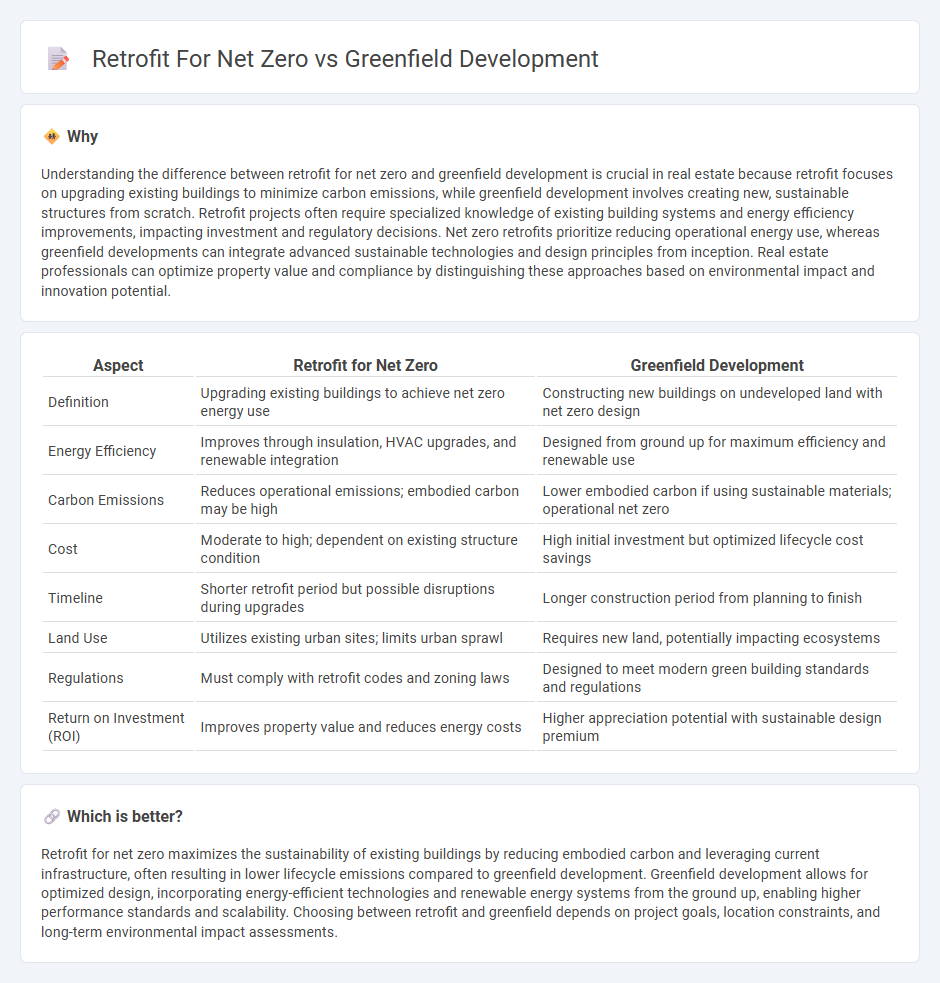
Retrofitting existing buildings for net zero focuses on upgrading infrastructure with energy-efficient technologies like solar panels, insulation, and smart HVAC systems to drastically reduce carbon emissions. In contrast, greenfield development allows for fully integrated sustainable design from the ground up, incorporating advanced renewable energy systems, sustainable materials, and optimized land use. Explore the key differences and benefits of each approach to sustainable real estate development.
Why it is important
Understanding the difference between retrofit for net zero and greenfield development is crucial in real estate because retrofit focuses on upgrading existing buildings to minimize carbon emissions, while greenfield development involves creating new, sustainable structures from scratch. Retrofit projects often require specialized knowledge of existing building systems and energy efficiency improvements, impacting investment and regulatory decisions. Net zero retrofits prioritize reducing operational energy use, whereas greenfield developments can integrate advanced sustainable technologies and design principles from inception. Real estate professionals can optimize property value and compliance by distinguishing these approaches based on environmental impact and innovation potential.
Comparison Table
| Aspect | Retrofit for Net Zero | Greenfield Development |
|---|---|---|
| Definition | Upgrading existing buildings to achieve net zero energy use | Constructing new buildings on undeveloped land with net zero design |
| Energy Efficiency | Improves through insulation, HVAC upgrades, and renewable integration | Designed from ground up for maximum efficiency and renewable use |
| Carbon Emissions | Reduces operational emissions; embodied carbon may be high | Lower embodied carbon if using sustainable materials; operational net zero |
| Cost | Moderate to high; dependent on existing structure condition | High initial investment but optimized lifecycle cost savings |
| Timeline | Shorter retrofit period but possible disruptions during upgrades | Longer construction period from planning to finish |
| Land Use | Utilizes existing urban sites; limits urban sprawl | Requires new land, potentially impacting ecosystems |
| Regulations | Must comply with retrofit codes and zoning laws | Designed to meet modern green building standards and regulations |
| Return on Investment (ROI) | Improves property value and reduces energy costs | Higher appreciation potential with sustainable design premium |
Which is better?
Retrofit for net zero maximizes the sustainability of existing buildings by reducing embodied carbon and leveraging current infrastructure, often resulting in lower lifecycle emissions compared to greenfield development. Greenfield development allows for optimized design, incorporating energy-efficient technologies and renewable energy systems from the ground up, enabling higher performance standards and scalability. Choosing between retrofit and greenfield depends on project goals, location constraints, and long-term environmental impact assessments.
Connection
Retrofit for net zero targets existing buildings by improving energy efficiency through insulation upgrades, HVAC modernization, and renewable energy integration, drastically reducing carbon emissions. Greenfield development complements this by applying sustainable design principles from the ground up, including smart site selection, passive solar design, and low-impact construction materials. Together, retrofitting supports decarbonizing the built environment while greenfield projects set new standards for environmentally responsible urban expansion.
Key Terms
Site Selection
Site selection for greenfield development prioritizes undeveloped lands with optimal solar exposure, wind potential, and minimal environmental disruption, enabling integrated net zero infrastructure from project inception. Retrofit projects focus on existing sites that often require complex upgrades to achieve energy efficiency, renewable integration, and emission reductions within existing spatial constraints. Explore detailed strategies to optimize site selection for achieving net zero goals in both greenfield and retrofit projects.
Energy Efficiency
Greenfield developments enable the integration of cutting-edge energy-efficient technologies, such as advanced insulation materials, passive solar design, and smart HVAC systems, from the ground up, ensuring optimal net zero performance. In contrast, retrofitting existing buildings often faces challenges like structural limitations and outdated systems, requiring innovative upgrades like high-efficiency heat pumps and building envelope improvements to achieve substantial energy savings. Explore detailed comparisons and strategies to optimize net zero outcomes in both greenfield projects and retrofit scenarios.
Carbon Footprint
Greenfield development typically offers lower carbon footprints compared to retrofit projects due to the ability to integrate cutting-edge, energy-efficient technologies from the ground up. Retrofit projects, while challenging, can significantly reduce emissions by upgrading existing structures with innovative insulation, renewable energy systems, and advanced materials, though often with higher embodied carbon. Explore further to understand the precise carbon savings and strategies for achieving net zero in both approaches.
Source and External Links
A Guide to Greenfield Development - This guide explains what greenfield development is, its benefits, and how it differs from brownfield development, highlighting its advantages in project management and infrastructure creation.
What Is Greenfield Development? - Greenfield development refers to real estate development on previously undeveloped areas, often controversial due to environmental concerns and regulatory restrictions.
Greenfield & Brownfield Industrial Developments - This resource compares greenfield and brownfield developments, outlining their pros and cons, including flexibility, cost, and environmental considerations for each type.
 dowidth.com
dowidth.com